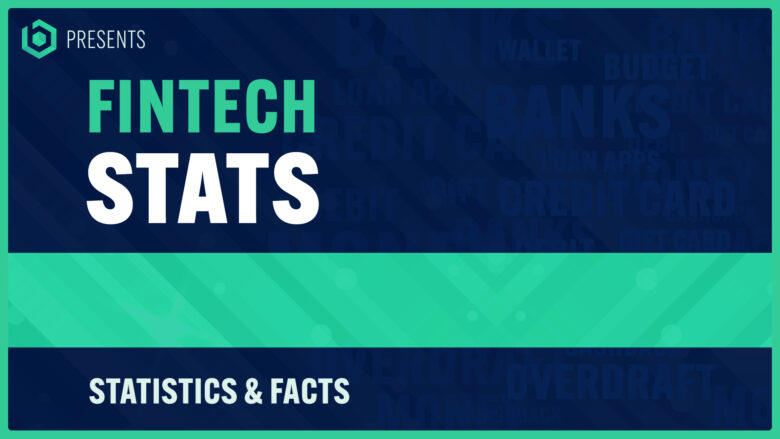The fintech industry has rapidly evolved, transforming the landscape of financial services with innovative solutions for payments, data management, alternative finance, and more.
This growth has led to a surge in new startups and investment opportunities across the globe. This article will delve into the fascinating world of fintech statistics that reveal its astonishing impact on our lives – from mobile banking apps to digital currencies and beyond.
- The fintech industry has witnessed significant growth in recent years, with a projected revenue of $169.32 billion by 2027.
- Venture capital funding in fintech reached a record-breaking $104 billion globally in 2022, thanks to increasing adoption rates for digital payments and mobile platforms.
- North America leads the way for fintech startups globally, while Europe is home to several popular neobanks. Meanwhile, Asia-Pacific’s high-growth companies include Ant Group, Grab Financial Group, Paytm and Airwallex.
- Consumer adoption of fintech continues to rise as more people opt for online financial solutions over traditional banking methods.
50 Interesting Fintech Stats and Facts

Here are some interesting and up-to-date fintech statistics:
- Fintech bank assets grew by 105% from 2013 to 2022, while traditional bank assets grew by 75%.
- Fintech companies acquired $210 billion in global investments in 2021.
- As of October 2022, there were 323 unicorn fintech companies worldwide.
- The per-share value of the Global X Fintech ETF halved from $52 in 2021 to $21 in 2022.
- The total transaction value of digital payments is expected to reach $8.49 trillion by the end of 2022.
- Insurance fintech companies raised about $15 billion in investments in 2021.
- By the end of 2022, 42.5% of motor insurance premiums in the US will be sold using online sales.
- The total value of assets in decentralized finance (DeFi) was around $90 billion in December 2021.
- Only 28% of traditional banks have the tools to use customer data for AI-based personalization.
- 66% of customers expect financial institutions to digitize everything from customer interaction to sales and service models, and descale brick-and-mortar infrastructure by 2025.
- Fintech companies acquired $210 billion in global investments in 2021.
- Fintech investment reached $107.8 billion in the first half of 2022, with the market shifting towards the Asia-Pacific region.
- Global venture capital activity in the fintech market dropped from $66.5 billion in H2 2021 to $52.6 billion in H1 2022.
- In 2018, Chinese payment service Ant Financial had the biggest round of investments in history, with $14 billion raised.
- The APAC fintech market size is expected to grow with a compound annual growth rate (CAGR) of 22.1% from 2021 to 2030.
- San Francisco-based Stripe, worth $95 billion, is perched atop the list of America’s largest financial technology companies.
- Nearly 60% of people under 35 in Brazil use neobanks instead of traditional banks.
- In 2021, the bank-owned fintech payment processing platform Zelle had a bigger payment volume ($490 billion) than Venmo and Cash App combined ($405 billion in total).
- For 55% of the US population, safety fears about sharing financial data are the biggest deterrent to adopting digital services and open banking.
- The total transaction value of digital payments is expected to reach $8.49 trillion by the end of 2022.
- Chatbots will save banks $7.3 billion by 2023.
- Artificial intelligence will save the insurance industry nearly $1.3 billion by 2023.
- By the end of 2022, 42.5% of motor insurance premiums in the US will be sold using online sales.
- Insurance fintech companies raised about $15 billion in investments in 2021.
- Fintech startups dealing with wealth management have a projected CAGR of 16.8% from 2020 to 2030, the highest among all wealth-management provider types.
- Global fintech statistics for 2021 tell us that the digital lending market earned $10.5 billion that year.
- VC funding for blockchain startups reached 25.4 billion in 2021.
- The list of the top fintech companies is crowned by GoTo, an Indonesian enterprise with a market capitalization of $2.846 trillion as of November 1, 2022.29. Global fintech funding increased 55% quarter-over-quarter (QoQ) in Q1’23. However, excluding Stripe’s massive $6.5B round, funding fell 12%.
- Deal count in fintech dropped for the fourth straight quarter to hit 983 in Q1’23.
- Early-stage deal share reached 72%, a new high in Q1’23.
- Unicorn births in fintech fell to 1 for the first time since 2016.
- Fintech M&A exits rebounded, increasing 15% QoQ in Q1’23.
- Banking funding and deals hit their lowest levels since Q2’17.
- Global fintech funding hit $15B in Q1’23, a 55% increase QoQ.
- Stripe’s enormous $6.5B Series I round accounted for more than 40% of the quarter’s total funding amount.
- Seventy-two percent of deals were early-stage in Q1’23, up from 69% in full-year 2022.
- The largest seed round ($45M) in Q1’23 went to UK-based carbon credit settlement platform Carbonplace.
- The only unicorn born in Q1’23 was Egypt-based MNT-Halan, a lender for the underserved, which entered the unicorn club at a $1B valuation.
- The total fintech unicorn herd stood at 314 in Q1’23, up 11% YoY.
- Fintech M&A exits rebounded 15% QoQ to reach 172 deals in Q1’23, marking a 34% decrease from their record high of 259 in Q1’22.
- The top M&A deal in Q1’23 went to Spain’s PAYCOMET, which Nexi acquired for $371M.
- Funding to banking-focused fintechs fell 64% QoQ to reach $0.5B in Q1’23 — its lowest level since Q2’17.
- Early-stage deals in banking accounted for 60% of the total for Q1’23 — a 5-year high.
- The top early-stage banking deal ($28M Series A) went to Spiral, a neobank for charitable donations.
- Fintech funding and deal count were down 94% and 63% in Q1’23 compared to Q2’21’s record highs.
- Payments, digital lending, insurtech, and capital markets all saw funding increase QoQ in Q1’23.
- The largest quarterly funding drop across all fintech categories in Q1’23 was in banking-focused fintechs, with a 64% QoQ drop.
- Wealth tech funding only dropped by 24% QoQ in Q1’23.
- The only IPO with a disclosed valuation ($25M) in Q1’23 was for TAP Global, a Gibraltar-based crypto platform.
- The Irish payment processing platform, Stripe is valued at $95 billion.
Overview Of The Fintech Industry
Fintech, short for financial technology, refers to the use of technology and innovation to offer financial services by startups and established financial institutions.
Definition Of Fintech
Fintech, or financial technology, refers to the innovative use of technology within the financial services sector to improve traditional processes and create new avenues for businesses and consumers.
The advancements in fintech have transformed various aspects of finance, including banking, lending, payments, investing, insurance, and more.
New fintech startups have emerged as competitors to established financial institutions by offering faster transactions, lower fees, and enhanced user experiences. Examples include mobile payment platforms like Venmo or PayPal that facilitate peer-to-peer money transfers without requiring a physical bank account.
Another example is online lending platforms such as LendingClub, which provide alternative financing options for borrowers who may not qualify for conventional loans from banks.
Fintech Market Size And Growth
The fintech market has witnessed remarkable growth in recent years, reshaping the financial services landscape and revolutionizing how businesses and consumers handle transactions.
With projected revenue of $169.32 billion by 2027, the industry shows no signs of slowing down.
Fintech startups have emerged at an impressive pace across various regions, with North America leading the way followed by Europe and Asia-Pacific. In particular, China is home to some of the largest fintech companies worldwide alongside its American counterparts.
The total transaction value of digital payments is expected to skyrocket to $8.49 trillion by the end of 2022 as more people embrace convenient payment methods through their smartphones or other devices.
Fintech Investment Statistics

Venture capital funding in fintech continues to grow, with a record-breaking $104 billion invested globally in 2022.
Venture Capital Funding In Fintech
Venture capital funding in fintech has experienced massive growth in recent years, breaking records and driving the industry forward. The table below showcases some key facts in venture capital funding for fintech companies.
| Year | Investment Value | Notable Investment |
|---|---|---|
| 2022 (Q1) | $10.9 billion | Crypto startups |
| 2021 | $107.8 billion (H1) | Overall fintech investment |
| 2017-2021 | Significant growth | Adoption rates, startups, investments |
| Top Regions | North America, Europe, Asia Pacific | Regional fintech startups |
Largest Fintech Deals
Fintech has experienced drastic growth over the years, with several high-profile deals making headlines in the industry. The following table showcases the largest fintech deals, highlighting essential aspects of these remarkable transactions.
| Company | Deal Value (USD) | Year | Investor(s) |
|---|---|---|---|
| Afterpay | 29 Billion | 2021-2022 | Square |
| Blackstone | 20 Billion | 2021 | Thomson Reuters |
| Worldpay | 17.6 Billion | 2019 | Fidelity National Information Services |
| Refinitiv | 17 Billion | 2020 | London Stock Exchange Group |
| First Data | 15.6 Billion | 2019 | Fiserv |
Leading Fintech Companies
The fintech industry is led by an array of startups and established companies, with notable unicorns such as Stripe and neobanks like Revolut and Wise gaining popularity among consumers.
Fintech Unicorns
Fintech unicorns are privately-held fintech companies with a valuation of over $1 billion. Here are some of the most notable fintech unicorns:
- Stripe – an Irish payment processing platform valued at $95 billion
- Klarna – a Swedish online payment and banking company valued at $45.6 billion
- Robinhood – an American commission-free trading app valued at $11.7 billion
- Chime – an American neobank valued at $14.5 billion
- Brex – an American corporate credit card provider valued at $7.4 billion
- Nubank – a Brazilian digital bank and credit card provider valued at $30 billion
- TransferWise (now called Wise) – a UK-based money transfer service valued at $11 billion
These unicorns have disrupted traditional financial industries by providing innovative services through technology, mobile platforms, and alternative finance methods such as peer-to-peer lending and blockchain technology.
Europe has numerous highly popular fintech companies, including neobanks like Revolut and Wise, while North America has the highest number of fintech startups globally, followed by Europe and the Asia Pacific region.
Visa is currently the largest fintech company worldwide based on market capitalization in 2022, while Afterpay was the largest fintech deal worldwide in 2021 and 2022.
As per the global fintech industry outlook, it is expected to generate revenue of 169.32 billion USD by 2027, which shows a positive trend towards its growth and expansion across regions alike, making it one of the most lucrative industries to invest in today’s times.
High-Growth Fintech Companies In Asia-Pacific
As the fintech industry in Asia-Pacific continues to prosper, some firms have emerged as clear leaders. Here are some high-growth fintech companies from the region:
- Ant Group – with a valuation of $315 billion in 2020, Ant Group is a comprehensive fintech player offering services from mobile payments to loans and insurance.
- Grab Financial Group – part of the ride-hailing giant Grab, Grab Financial offers services such as payments, lending, and insurance products across Southeast Asia.
- Paytm – India’s leading mobile payments provider, Paytm has over 350 million users and has expanded its offerings to include ticketing and e-commerce.
- Airwallex – founded in Australia, Airwallex has become one of the fastest-growing cross-border payment platforms globally, with offices in Asia-Pacific, Europe and North America.
- Gojek – another Southeast Asian ride-hailing giant that has ventured into fintech through its GoPay service and has grown to be valued at $10 billion in 2019.
These companies have demonstrated impressive growth through innovative business models and cutting-edge technology solutions for various financial services needs.
Fintech Market Share By Region

The global fintech market is growing rapidly, with significant regional disparities and trends that reflect diverse market conditions and consumer needs.
Global Fintech Trends
The global fintech industry has been experiencing a significant shift in trends, driven largely by the increased adoption of digital payments and mobile banking. As digital transformation continues to evolve at an unprecedented pace, more consumers are opting for online financial solutions than traditional banking methods.
In addition, advancements in technologies such as blockchain and artificial intelligence (AI) have revolutionized the way financial services operate. Blockchain technology offers improved security and transparency while reducing transaction costs, making it particularly attractive to companies seeking efficient payment solutions.
Meanwhile, AI is increasingly used in areas like risk assessment and fraud detection, demonstrating its potential to transform many aspects of the financial industry.
Regional Fintech Statistics
The fintech market has witnessed significant growth across different regions globally, with each region playing a crucial role in developing and using fintech solutions. The following table shows an overview of regional statistics in the fintech industry, including the number of fintech startups and investment deals.
| Region | Number of Fintech Startups | Share of Investment Deals (2018-2022) |
|---|---|---|
| North America | Highest number of fintech startups globally | U.S. has the highest share of investment deals |
| Europe | Home to numerous popular fintech companies | Significant investment deals in neobanks and digital payment solutions |
| Asia Pacific | High-growth fintech companies, particularly in China and India | Substantial investments in digital lending and payment platforms |
| Africa | Emerging fintech market focused on financial inclusion | Increasing investment in mobile money and remittance services |
| Latin America | Rapid growth of fintech startups driven by unbanked population | Investments mainly in digital banking and financing solutions |
| Middle East | Surge in fintech innovation due to regulatory support | Investments in digital banking, insurtech, and wealth management |
These regional differences highlight the unique challenges and opportunities that each market presents, shaping the landscape of fintech globally.
Fintech Consumer Adoption Statistics
Consumers’ adoption of fintech continues to rise, with mobile platforms being the preferred mode of accessing financial services.
Consumer Experience In Fintech
Consumers play a vital role in the development and growth of fintech companies. Their experience with fintech solutions can make or break the success of these innovative products and services.
The adoption rate of fintech has been increasing globally, with digital payments having the highest number of users worldwide. Mobile banking apps have been gaining popularity as more consumers prefer to manage their finances on-the-go.
However, challenges such as cybersecurity threats, complicated KYC procedures, privacy concerns, and trust issues may arise when dealing with financial transactions online.
For instance, mobile payment platforms like Ant Financial’s Alipay have faced criticism for their data collection practices and security measures. It is essential for fintech companies to prioritize customer safety while ensuring that their platforms remain accessible and user-friendly.
Mobile Platform Usage
As the fintech industry continues to evolve and expand, mobile platform usage has become increasingly important. With more consumers relying on their smartphones for financial transactions and management, the use of mobile apps in fintech has grown exponentially over the years.
Mobile banking apps have also grown significantly, with many traditional banks now offering a range of services through their own bespoke apps. This has led to increased competition among fintech companies looking to capture market share through user-friendly interfaces and unique features.
In summary, mobile platform usage is a crucial element in both consumer adoption and innovation within the fintech industry.
Fintech Sub-sectors Statistics
Explore the latest fintech sub-sector statistics, including insights into blockchain and cryptocurrency, artificial intelligence in finance, and the impact of traditional banking versus fintech.
Discover how these sectors are advancing and driving innovation in the industry.
Blockchain And Cryptocurrency
Blockchain technology and cryptocurrency have been some of the most significant innovations in fintech. The rise of blockchain has given birth to various opportunities for financial institutions, especially in terms of security, efficiency and transparency.
With its decentralized nature, blockchain eliminates intermediaries from the transaction process, making it more cost-effective. In 2021, cryptocurrencies like Bitcoin (BTC) and Ethereum (ETH) have continued to ascend despite concerns over government regulation and volatility.
The potential benefits of these technologies go beyond digital currency investments as their application extends into other sub-sectors of finance such as cross-border payments, supply chain management systems and even voting systems all with enhanced data privacy protections through encrypted verification systems that are resistant to fraud or manipulation.
Artificial Intelligence In Fintech
Artificial intelligence (AI) has become a game-changer in the fintech industry. It offers unprecedented benefits such as personalization, fraud detection, and regulatory compliance.
For instance, robo-advisors use machine learning algorithms to analyze investment portfolios based on risk tolerance, goals and preferences which enable personalized advisory solutions.
Moreover, AI helps fight fraud by detecting anomalies in transactions through predictive modeling techniques. With evolving regulations around anti-money laundering (AML), KYC requirements have become increasingly complex.
The integration of artificial intelligence within fintech is continuously increasing with its capabilities estimated to grow at a rate of 23% annually from 2021-2025 according to recent market research reports
Traditional Banking Vs. Fintech
Traditional banking and fintech both offer unique advantages and disadvantages, but together they provide a complementary approach to financial services. Explore the differences and similarities between these two financial models in the table below.
| Aspect | Traditional Banking | Fintech |
|---|---|---|
| Scope of Services | Offers a wide range of financial services such as deposit and lending services, investment management, and insurance products. | Focuses on specific financial services, leveraging technology to provide innovative solutions in areas like online and mobile payments, big data, alternative finance, and financial management. |
| Technology Integration | Relies on established systems and processes, with gradual adoption of new technologies to enhance customer experience. | Emphasizes the use of cutting-edge technology to develop and deliver financial services, often utilizing AI, machine learning, and data analytics. |
| Market Reach | Well-established brands with global presence, catering to a large and diverse customer base. | Typically targets specific markets and segments, with a focused approach allowing for rapid growth and market penetration. Some fintech companies have achieved global growth, such as Revolut and Wise. |
| Regulation | Highly regulated, with stringent compliance requirements and oversight from government authorities. | Regulatory environment is still evolving, with an increasing focus on creating rules and standards that support innovation while protecting consumers. |
| Customer Trust | Benefits from a long history of providing financial services, with established trust and loyalty among customers. | Building trust can be challenging for new fintech providers, but positive customer experiences and testimonials can help build credibility and trust over time. |
| Access to Capital | Access to large amounts of capital through traditional sources such as deposits and loans. | Startups often rely on venture capital funding, with fintech investments reaching $210 billion in 2021. However, investments decreased in 2022, with early-stage fintech companies attracting the most attention. |
COVID-19’s Impact On Fintech Industry
The COVID-19 pandemic has brought significant changes to the fintech industry, with a shift in consumer behavior towards contactless payments and digital banking services, as well as an increase in demand for financial inclusion initiatives.
Discover how the industry has adapted and what future predictions lie ahead.
Industry Resilience And Adaptation
The fintech industry has shown remarkable resilience and adaptability during the COVID-19 pandemic. As traditional financial institutions struggled to cope with market volatility, fintech companies were able to pivot quickly, providing essential services such as online payments, digital lending, and investment advice.
B2B fintech companies focused on online lending received the most funding during this time. The pandemic accelerated the shift toward contactless payments and mobile banking apps as consumers avoided physical bank branches.
One example of this is Ant Financial’s Alipay app in China. During the early months of the pandemic, Alipay created a feature that allowed users to check their health status before entering public spaces or traveling domestically.
This initiative proved popular with Chinese consumers who appreciated how it helped them navigate restrictions related to COVID-19 safely.
Shifts In Consumer Behavior
As the world becomes increasingly digitized and automated, consumer behavior has shifted towards more online transactions. The COVID-19 pandemic accelerated this trend as people turned to digital payments out of necessity when physical stores were closed, resulting in a surge in mobile app usage within the fintech industry.
Notably, digital payment users during the pandemic were primarily low-income individuals making up 55% of total users. Additionally, fintech companies are becoming increasingly trusted by younger generations with 51% of those aged 18 to 24 and 49% of those aged 25 to 34 trusting fintech.
Fintech Statistics For The Underbanked
Fintech initiatives have made significant progress in expanding financial inclusion, with 1.7 billion adults worldwide without access to a bank account.
Financial Inclusion Initiatives
Fintech companies are increasingly focusing on financial inclusion initiatives to provide access to essential financial services to underbanked populations. Some of the key initiatives undertaken by fintechs include:
- Providing digital bank accounts that can be opened without needing a physical address or government – issued identification.
- Offering low – cost loans and credit options for individuals who lack access to traditional banking services.
- Developing mobile payment platforms that allow for easy and secure money transfers, even for individuals without a bank account.
- Partnering with traditional banks to offer financial products and services to underserved communities.
- Using alternative data sources, such as social media activity or utility bills, to assess creditworthiness and provide access to financing for those who might be denied by traditional lenders.
- Focusing on financial education programs that help individuals better understand basic financial concepts and make informed decisions about their finances.
Through these efforts, fintech companies are helping to address the financial needs of underserved populations, reducing reliance on expensive alternative financial products and promoting greater economic mobility.
Opportunities For Growth
The fintech industry has the potential to make a significant impact in providing financial services to the underbanked and unbanked population. With more than 38 million Americans being underbanked or unbanked, there is plenty of room for growth in the fintech sector.
The rise of digital payments and lending firms during the pandemic has particularly benefited low-income individuals who were previously excluded from traditional banking options due to various reasons such as lack of credit history or identification papers.
Fintech companies focusing on financial inclusion initiatives can tap into this underserved market by offering affordable, accessible, and convenient financial products specifically designed for them.
According to recent statistics, retail-facing fintech companies saw a significant increase in gross values transacted last year alone. Traditional banks are lagging behind in terms of digitization and personalization compared to fintech rivals.
This presents an opportunity for collaboration between established institutions and innovative startups whereby they can leverage each other’s strengths through mutually beneficial partnerships fostering positive disruption across industries.
Key Insights And Future Predictions
Key insights suggest that established financial giants and fintech innovators will form closer relationships, leading to a significant increase in collaborations and mergers.
Future predictions also indicate that the adoption rate of decentralized finance (DeFi) and chatbots will rise, while cybersecurity will become an even more pressing issue for the industry.
Relations Between Established Financial Giants And Fintech Innovators
As the fintech industry continues to grow at an unprecedented rate, established financial giants are increasingly finding themselves in direct competition with up-and-coming fintech startups.
Many banks are now partnering with fintech companies to develop new products and services, while also investing in or acquiring them outright. For example, JPMorgan Chase recently acquired online payments platform WePay, while Goldman Sachs has invested in consumer lending startup Marcus.
Such collaborations can help established firms bring innovative solutions to market more quickly, while giving startups access to greater resources and expertise.
Emerging Fintech Trends
Fintech has continued to evolve, and new trends are emerging in the industry. Here are some of the most notable emerging fintech trends:
- Decentralized Finance (DeFi): This is a new financial system that relies on blockchain technology to provide financial services without intermediaries. DeFi platforms provide services such as borrowing, lending, and trading digital assets.
- Chatbots and Robo-advisors: Fintech companies are increasingly using chatbots and robo-advisors to provide personalized investment advice to customers. These technologies can help streamline customer interactions with financial advisors.
- Biometric Authentication: As security becomes more critical for financial transactions, biometric authentication methods such as facial recognition and fingerprint scanning are becoming more popular.
- Open Banking: With open banking, banks share their data with third-party providers, allowing customers to use financial apps outside of the traditional banking system.
- Cybersecurity: As cyber threats become more sophisticated, fintech companies are investing heavily in cybersecurity measures to protect customer data from breaches and other malicious attacks.
- Artificial Intelligence (AI) and Machine Learning: AI is being used to automate many tasks in the financial industry, from anti-money laundering efforts to fraud detection.
- Digital Identity Verification: In an age where identity theft is prevalent, fintechs have started developing digital identity verification tools that make it easier for individuals to verify their identities online quickly.
Overall, these emerging fintech trends demonstrate how technology continues to shape the future of finance by making it more accessible, secure, and efficient for everyone involved in the financial ecosystem.
Our Takeaway
In conclusion, the fintech industry has experienced remarkable growth and development over the past decade, with a wide array of innovative solutions and investment opportunities emerging across various subsectors.
Although 2022 saw some challenges for the sector, particularly in terms of job cuts and decreased investments in certain regions, seed-stage startups continue to attract attention and record investments.
As digital payments remain one of the most popular fintech sectors globally, there is significant potential for continued growth and expansion in this field as well as other areas such as blockchain technology and artificial intelligence.
Article Sources & Helpful Links
Here are some helpful links that may help you learn more:
Fintech Statistics (FAQs)
What is fintech?
Fintech refers to the innovative technologies and solutions that are used to enhance and automate financial services.
What are some examples of fintech services?
Fintech services can range from mobile banking apps and payment processing solutions to robo-advising platforms and blockchain technology.
What are some fintech trends to watch for in 2021 and beyond?
Some key fintech trends to keep an eye on include the continued growth of blockchain technology, the rise of fintech hubs throughout the world, and the increasing adoption of fintech products and services by both consumers and businesses.
What are some statistics about the fintech industry?
According to fintech industry statistics, the global fintech market is projected to reach over $305 billion by 2023 and beyond. Additionally, the compound annual growth rate of the fintech industry is expected to remain high, with investment in fintech companies continuing to increase.
Who are some of the biggest players in the fintech industry?
Some of the top fintech companies include PayPal, Square, Stripe, Ant Group, and Adyen.
What is the adoption rate of fintech services?
Fintech adoption rate varies by region, but on average, at least one fintech service is used by approximately 33% of consumers worldwide.
What is fintech funding?
Fintech funding refers to the process in which startup fintech firms receive financial backing from investors in order to develop and launch their products or services.
What are some fintech blockchain statistics?
Some key fintech blockchain statistics include that blockchain technology is expected to revolutionize the financial services industry, providing secure, transparent transactions that are faster and more efficient than traditional banking methods.
What is the fintech industry size?
According to recent fintech industry reports, the size of the global fintech market is estimated to be over $100 billion in 2021.
What are some key fintech services that are being adopted by consumers?
Some of the most popular fintech services being adopted by consumers include mobile banking apps, digital wallets, and P2P payment solutions.




